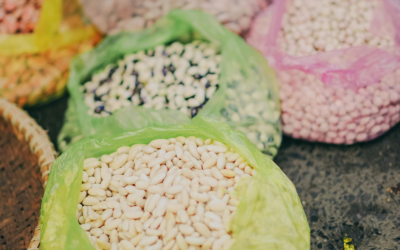What is protein at a molecular level?
There are three macronutrients that power the body; protein, carbohydrates, and fat. Macronutrients are essential, meaning we must obtain them from the diet. Protein makes up the bones, muscles, skin and hair, and powers many chemical reactions that take place in the body. Protein is made up of 20 different building blocks called amino acids. Some foods contain all 20 amino acids while others contain only some, but the body puts these dietary amino acids from different protein sources together to create various proteins. It is important to consume enough protein to power the body and allow for these reactions to occur. *Hint hint, you probably already do.*
Myths about protein
There are umpteen myths surrounding a protein-rich meal plan and protein diet plans that need to be busted before you understand your ideal protein intake.
- Protein will make me gain muscle– Due to its important role in muscle maintenance, protein powders, high protein foods, and protein diet plans are often marketed to help us gain muscle. While your body does need more protein than it normally does when you are working out or body building, eating protein alone will not do anything to increase your muscle mass.
- Eating more protein will help me lose weight- Though adequate consumption of protein helps to keep you fuller longer, focusing on incorporating more protein sources and eating more of this macronutrient alone can lead to an imbalance in your diet. Eating an excess of protein may cause a person to not consume enough carbohydrates, fat, and other nutrients, which may cause problems like vitamin deficiencies, or poor performance during activities.
- Most people are not getting enough protein- Protein deficiency in the United States is pretty rare, since most people eat meat, dairy, eggs and other animal products. Americans tend to eat 2x their recommended intake of protein per day.
- Vegetarians and vegans cannot get enough protein– This is a very common way of thinking, especially amongst those who are resistant towards trying a more plant based lifestyle. While animal products are a protein source that contain a higher amount of protein per serving, grains, legumes, tofu, and even vegetables contain protein, so as long as the individual is creating balanced meals, they can definitely reach their protein goals.
How much protein should I get per day?
The recommended amount of protein needed per day is based on activity level and weight. Each protein diet plan is tailored to the individual based on certain factors. To find out how much you need from your protein sources, start by converting your weight from pounds to kilograms by dividing it by 2.2.
- Ex: 150 lbs/2.2 → 68kg
Next, determine your activity level. For sedentary adults, multiply that number by .8. This will be your goal protein range for the day in grams. Individuals who are under stress (such as illness or injury), pregnant, recovering from an illness, or frequently engaging in endurance or weight training, will need to multiply by 1.2 to 2. This will be your new goal in grams. To continue with the example above, if that same 150lb individual is a student who does not exercise regularly but walks to and from class every day, they will be on the low end of protein intake. However, if they start intensely training in the gym 5 days per week, their protein needs may go up to the high end, demanding a better protein diet plan. In the case of exercise, a typical 3 oz. serving of protein within 60 minutes of a workout will be a good protein source and will be enough to help the muscles recover.
- Sedentary 150 lb individual: 68kg (.8-1) → goal of 55-68g protein per day
- Same individual, weight/endurance training 5x per week: 68kg (1.2-2) → goal of 82-136g protein per day
The most important part of protein intake is making sure you are within the recommended range of intake. It can be easy to get caught up in the numbers of this macronutrient, but incorporating a protein source at each meal and after physical activity is a great baseline to aim for. If you would like to learn more about an individualized nutrition and protein diet plan that is specific to you, speaking with a Health Loft dietitian can bring you confidence in knowing you are on the right track with your nutrition.
What are the best protein sources?
Animal products will be the foods that contain the highest amounts of protein, making them among the best protein sources. It is, however, important to understand that “grams of protein” isn’t the only thing to look for when selecting what foods to consume. Take these three examples:
- 4 ounce serving of sirloin steak will provide about 33 grams of protein. However, it will also provide 5 grams of saturated fat, which if consumed in excess can be harmful to the heart.
- 4 ounces of ham will provide 22 grams of protein, and only 2 grams of saturated fat. However, it contains 1,500 milligrams of sodium which, if consumed frequently, can have negative effects on blood pressure.
- 4 ounces of salmon has about 30 grams of protein, provides only 1 gram of saturated fat and is naturally low in sodium. Salmon and other fatty fish like tuna, trout, and sardines are also excellent sources of omega-3 fats which help protect the heart.
On average, it is recommended to make ¼ of your plate a protein source. This can be accomplished by 3-4 ounce portions of meat, fish or poultry, or by incorporating a plant-based source (listed below.) Protein should be included with every meal, as we need to refuel our body as we use energy throughout the day. Common portion sizes of protein include:
- 4 oz steak → 33 g
- 4 oz fish→ 30g
- 4 oz chicken or turkey→ 30g
- 6 oz plain greek yogurt → 17g
- ½ cup cottage cheese → 14g
- 2 eggs → 12g
What are some plant-based protein sources?
Consuming animal products in the diet is commonly known to be the easiest way to meet your protein goal, however protein is readily available in many foods consumed by vegetarians every day. Below are plant-based protein options compared to the animal products above.
- One cup of cooked lentils provides about 18 grams of protein and 15 grams of fiber, and virtually no saturated fat or sodium.
- ½ cup cooked tofu contains 10 grams protein and minimal levels of saturated fat and sodium. It is also an excellent source of calcium and iron. These two minerals are often of concern in vegetarians and vegans due to their high presence in animal products which are not consumed by vegetarians and vegans.
Consuming plant-based proteins can also be a great way to boost fiber intake which is helpful for keeping us full, optimizing gut health and bowel function and preventing chronic diseases. Other sources of plant-based proteins include:
- One cup chickpeas, kidney bean, black beans, pinto beans → 15g
- One cup cooked quinoa, amaranth, farro, barley, spelt and other grains → 11g
- One cup wild rice or brown rice→ 7g
- One cup cooked broccoli, spinach, asparagus, artichokes, potatoes, sweet potatoes and brussels sprouts → 5 g
- One cup green peas → 9g
- 3.5 oz seitan → 25g
- 3.5 oz tofu, tempeh, edamame → 15g
- One cup cooked lentils → 18g
- ¼ cup nutritional yeast → 7g
- 2 tbsp chia and hemp seeds → 10g
- ½ cup dry oats → 6g
- 2 tbsp nut butters like peanut and almonds → 7g
Remember, it is important to consume adequate protein each day for optimal muscle and cell function. Protein needs may change based on activity level, but eating regular and balanced meals which contain a source of protein as ¼ of the plate will typically bring you to your desired protein level. This protein can come from animal-based foods, plant-based foods or a combination of the two. Making sure to include protein with every meal along with a source of carbohydrate and fruit or vegetable will ensure balanced meals and stable energy throughout the day!
Written by Marissa Gusmao Edited by Alexander Franz Reviewed by Morgan Murdock, RD.
REFERENCES
-
-
- https://www.ncbi.nlm.nih.gov/pmc/articles/PMC6893534/
- https://www.pcrm.org/good-nutrition/nutrition-information/protein
- https://www.hsph.harvard.edu/nutritionsource/what-should-you-eat/protein/
- https://www.health.harvard.edu/blog/how-much-protein-do-you-need-every-day-201506188096
- https://www.ncbi.nlm.nih.gov/pmc/articles/PMC4208946/
-










